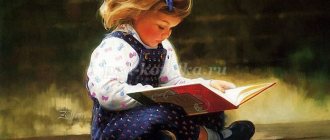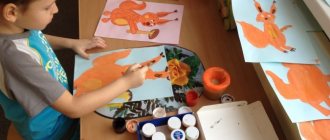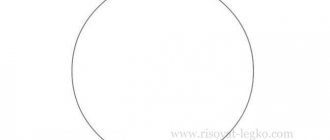Summary of work activities in the middle group. Lesson plan (secondary group)
Summary of labor activities in the middle group.
Topic: “Cleaning the group room.”
Type: economic and household work.
Program content:
Goal: To develop in children the ability to work in a team.
Educational: To instill in children a positive attitude towards work, a friendly attitude towards each other, a caring and attentive attitude towards others.
Educational: Teach children to distribute work among themselves in a team.
To consolidate children's knowledge about labor processes: caring for plants, dusting.
Developmental: Develop the ability to work carefully and bring the job started to the end.
Equipment: basins with water, rags, aprons, watering cans, cat toy.
Planned result: as a result of collective household work, children have formed a value-based attitude towards their own work and the work of their peers; children should understand that after their work the group became clean, light and beautiful.
Methods and techniques: Verbal play (conversation, explanation), visual
(showing a method of action), practical.
Progress of collective work:
Stage 1. Work motivation
Educator: Guys, today a fox came to visit us and brought you some kind of surprise. But in order to get it, you need to work hard. The fox noticed that there was dust on the shelves in our group and gave us the task of cleaning our group so that it would be clean and beautiful. But that is not all. Our plants are not doing well at all. Why do you think? (do not water). That's right, guys - our plants don't have enough water to feed them. Because of this, they got sick. The fox didn’t like it at all, she wants to see how we can water them.
Shall we complete our guest's tasks? (Yes). Then now we will decide who will carry out what task. And the fox will sit on a chair and watch our work.
Stage 2. Organization of labor activities.
The teacher brings out pre-prepared material - aprons, rags, basins, watering cans - and puts everything on the table.
Educator: Guys, let us divide into 2 teams. And before work, let's remember what and how we will do. We take the watering can in two hands (one hand by the spout, the other by the handle), pour half of the watering can in the toilet room, bring the end of the watering can's spout to the pot so that the spout of the watering can touches the pot and carefully tilt the watering can for watering. You need to water until water appears in the saucer under the pot. (teacher demonstration).
We put the rags in the water, wring them out, straighten them and wipe the shelves, chairs, tables so that there is no dust left anywhere (teacher demonstration). Guys, don’t forget that when you work, you need to be polite, not quarrel and help each other.
So, let's start tidying up. Don't forget to wear aprons to avoid getting your clothes wet. (The teacher approaches the children one by one, observes, controls, helps them work, and reminds them of the methods of work.)
Stage 3. The result of the work.
(The teacher offers to finish the work and start cleaning up the equipment. Helps to find a place for the equipment, fold it neatly).
Educator: Guys, let's now see what we got. Look, and the fox hurries to look at the work done. (The teacher brings the toy to his ear.) The fox says that you did a very good job and now wants to know why you did it? What benefit will our work bring? (children's answers). She really liked our work. How you carefully and accurately watered the plants, how cleanly you wiped the dust off the furniture. What hardworking guys! For this the fox wants to treat you
sweet gift. (The teacher brings out sweets). For your efforts, she gives you these delicious candies.
(teacher distributes treats)
Guys, it’s time for the fox to go home to her kittens, but she promises to come visit us again soon. (Children say goodbye, the fox leaves)
MAGAZINE Preschooler.RF
Notes on organizing collective work Topic: “Let's teach Masha to work” middle groupPrepared by: teacher Tishina Irina Andreevna Municipal budgetary preschool educational institution general developmental kindergarten No. 10 “Yolochka” , Moscow region, Ozyory
Contents: washing toys, furniture and indoor plants (2-3 units).
Educational field: Social and communicative development.
Program goals and objectives:
- developing a child’s positive attitude towards work
- develop work skills and improve them
- develop skills in organizing the work process
- to form friendly relations between children and each other, teach them to evaluate the activities of others, and make comments.
Organization: subgroup. I put on aprons for the children and myself in advance, and prepare the subject-development environment.
Equipment: three basins with water, 5 rippers, a watering can with water, rags and aprons according to the number of children.
Progress of work.
Introductory part:
a) To focus children on the social significance of work and responsibility for its implementation - we will arrange a bath day for our group. And for this we need to wash the toys, tables and chairs, flowers.
I gather the children on the carpet.
A surprise moment: the doll Masha came to visit
— Educator: Who came to us? What is your name? What are you doing in our group?
- My name is Masha. I heard that today is your bath day. While you were sleeping, I decided to help you clean up, I cleaned almost everything.
— Educator: Why are you so dirty? How did you clean up, nothing has changed in our group. Really, guys? (Truth)
- Well, I wiped the dust off the table (wipes the table with his hand)
— Educator: What are you talking about, who wipes the dust like that!
- So how should it be? (asks the children)
“With a napkin,” the children answer.
— Educator: How did you wipe the flowers?
- Why wipe them, here (blows on a flower), and everything is ready.
- This is absolutely no good. The guys need to teach Masha how to clean properly. Sit down Masha and watch carefully, now the guys and I will teach you how to clean up properly.
b) Explanation and demonstration of how to perform:
Educator: Guys, let's remember how to wash toys?
How to wash the chairs? (wash the back, legs, seat).
How should you care for indoor plants? (Wipe large leaves by carefully placing the leaf on your palm and wiping with the other hand) We do everything carefully and carefully!
c) Educator: We have a lot to do, and for this I will divide you into teams and choose the leaders. They will ensure that all tasks are completed and provide assistance.
(I specify the place of work of each link, what it will do; the emotional attitude towards responsible and high-quality performance.)
Check if you have everything you need to work.
Main part:
a) training in basic labor planning, i.e. teach children to organize their work:
— Educator: Let's see what is needed for work?
teach children to plan tasks:
-Where do we start? How will we do it? What will you do next? How? (if you need to clarify the actions).
teach managers to monitor and evaluate work:
-What will you check?
-How will you finish your work? (Target children, control that they check themselves during work and do not make mistakes).
-Remind you to remember to put everything back in its place after work.
b) Techniques for managing the work of individual units of children:
-example of an adult, demonstration, reminder, encouragement, explanation; example of children, organizing mutual aid for children, celebrating good deeds of children, encouraging mutual aid; bring the job started to completion; learn to work together and carefully.
c) Completion of the labor process: cleaning the workplace (leaders supervise the cleaning).
a) Summarize the work as a whole and by subgroups, note the importance of collective work;
b) Evaluation of the work of units and individual children: / evaluation is educational and encouraging. /
— Educator: What did your unit do and how? Who worked hard? How and in what ways did you help each other?
- involve children in assessing the work of another level (has everything been done, has the workplace been cleaned)
(fairness and friendliness of the assessment; we discuss in a tactful manner shortcomings in the work).
Well done boys! Masha has prepared riddles for you:
On a dark night, on a clear day, He fights with fire. In a helmet, like a glorious warrior, he hurries to the fire. (firefighter).
He lays bricks in a row, builds a kindergarten for the children, not a miner or a driver, but builds a house for us. (builder)
He knows the traffic rules without a doubt. He instantly starts the engine and rushes off in the car. (chauffeur)
Who in a clean white robe gives us vaccinations quickly? The kind one saves us from illnesses and failures... (doctor)
He flies high, soars above the ground easily. A brave guy lands a plane... (pilot)
Well done! Tell me what was said in the riddles (About professions.)
Final part:
- What did we do today?
— What did you like most?
-Now let's say goodbye to our guest.
| Next > |
Abstract of educational activities on labor education for children of the middle group
Abstract of the educational activity “Let's bake cookies” for children of the middle group
Author: Luzina Marina Aleksandrovna Position and place of work: Amur region.
city of Blagoveshchensk, teacher of MOAU pro-gymnasium Topic: “Let’s bake cookies” for children of the middle group
Description: summary of work activities for children of the middle group “Let’s bake cookies.” The main task of this lesson is to teach children to knead dough from certain products and weigh them in different ways: (scales, measuring cup, dividing butter by half). As well as the development of imagination when working with dough. Goal: introduce children to the method of making cookies Objectives: Learn to knead dough from certain products and weigh them in different ways: (scales, measuring cup, divide the product by gender) Development of imagination when working with dough
GCD move
Educator: Hello guys, I want to treat you to cookies. Do you know who makes it? Children: Yes, confectioners Educator: Do you know how they make it Children answer from their experience Educator: And today I want to teach you how to make cookies and play the role of a confectioner. Do you agree? Children: Yes Educator: then let's wash our hands, put on aprons and get to work Children put on aprons, wash their hands Educator: For a serving of cookies you need 200 grams. flour, 200 ml molak, 50 gr. sugar, 1 tsp. cinnamon and 100 gr. oils How do we measure them? Children: using scales Educator: On the table you have a tablespoon, a teaspoon, a measuring cup, scales and a table of measures of different products. How much flour do we need for cookies? Children: 200 grams Educator: How can we measure it? Children: using scales Measured and put in a bowl for dough Educator: How can we measure milk? Children: Using a measuring cup Teacher: How much cinnamon do we need for cookies? Children: 1 teaspoon Educator: Take a teaspoon and add it to the flour Children complete the task Educator: How much sugar and butter do we need? Children: 50 gr. Sahara. Educator: How can we measure these products? Children: Using scales The teacher shows how you can measure sugar using scales. Educator: Do you know that the weight of the product is also usually written on the packaging? Children: Yes Educator: Try to find it on this stick of butter Children are looking for numbers Educator: Who knows these numbers? Great, here's 200 grams. How can we take 100 grams? Children: divide in half. Educator: Correct, we need to divide by half. The teacher, together with the children, cuts off the required amount of food and kneads the dough. The dough needs to be put in the refrigerator for a while. Children at this time are practicing weighing food. Teacher: how much flour is in this bag? Who wants to weigh in? Weighing Educator: Now let's try to measure with a measuring cup. Measuring Educator: Guys, look, our dough has cooled. Now you need to roll it out, do not forget to sprinkle the table with flour so that the dough does not stick. Rolled out Educator: Now take the molds. Masha, Pasha, Katya - what shape is your mold? Educator: Now we’ll have a competition to see who can cut out the most cookies from one piece of dough, leaving as little waste as possible. Children cut out cookies. Educator: How many cookies did you get, Vasya, Zhanna, Kostya? Children: 2, 3, 2 Educator: Well, that's all, our cookies are ready, right, guys? And it can be eaten and consumed Children: No Educator: Why? Children: You still need to bake it. Educator: What can you bake cookies in? Children: In the oven Educator: Can a child set fire to the oven and cook cookies at home? Children: No Teacher: Why? Children: Dangerous Teacher: that’s right, now we’ll put our cookies on a baking sheet, greased with oil, so that the cookies don’t stick. We'll take it to our chefs and they'll bake it for us. What will the cookies be like after they are baked? Children: rosy, beautiful The teacher and the children go to the kitchen and take the cookies
Teacher: while our cookies are being prepared, let’s remember all the stages of work and depict them with symbols 1. Discuss the cookie recipe 2. Select the right products 3. Measure out the right amount 4. Mix the products 5 Kneaded the dough 6. Cooled 7. Sprinkled the table with flour 8. Rolled out the dough 9. Cut out the cookies with molds 10. Coated the baking sheet with butter 11. Placed the cookies on the baking sheet 12. Coated with egg 13. Put the oven to bake 14. Took out the finished cookies 15. Tried it While we are making up stages of preparing cookies, the cook brought them and put them on the table.
Educator: And now guys, I invite you to drink tea with our cookies
We recommend watching:
Summary of educational activities in the middle group of a speech therapist teacher using the method of hippotherapy. Notes of cognitive and research activities in the middle group. Notes of educational activities in the middle group. Wild animals in winter Summary of educational activities for familiarization with the outside world for children of the middle group
Similar articles:
Training children of the younger group in labor activities
Formation of hard work in preschool children
Folklore entertainment in the middle group
Lesson summary on the topic “Mood” in the middle group
Lesson summary for the middle group on the topic: Transport




